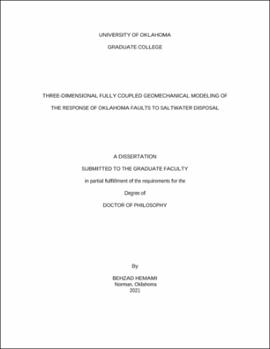| dc.description.abstract | In the last decade, parts of the Central United States experienced marked increase in the number of small to moderate-sized earthquakes. Among all states, Oklahoma has experi-enced the most increase in the number of earthquakes. The seismic activity has been at-tributed to injection of wastewater produced from oil/gas activities. Induced seismicity is associated with injection (or production) operation in the subsurface which perturbs the in-situ pore pressure and total stresses. It is expected that injection causes nearby faults reacti-vation at reservoir depths by reducing normal effective stress acting on the fault plane. But, the majority of notable induced earthquakes happen on faults within the basement kilome-ters away from injection wells. In some cases (e.g. Prague 2011 sequence), there are many years delay between the start of injection operation and induced earthquakes. Many stud-ied have been performed to explain the discrepancy between the observation and what happened in the reality. Many of them neglected the poroelastic effect, and only focused on the direct pore pressure. Many others, did not consider other determining factors such as hydromechanical properties of the reservoir and the basement, fault architecture, etc.
In the absence of a comprehensive geomechanical study of induced seismicity and the fact that Oklahoma was the host of the most induced seismicity events in the last decade, we evaluated the different possible scenarios of injection-induced seismicity by the construc-tion of a conceptual geomechanical model. We studied the direct role of pore pressure dif-fusion and the indirect poroelastic stress transfer effect on the failure of a favorably orient-ed strike-slip fault with an initial condition similar to Oklahoma. By using a three-dimensional coupled numerical model, we study the effect of different factors such as me-chanical properties of the reservoir and the fault zone, the relative direction of in-situ stress and fault strike, etc. on the response of the fault to the injection.
We show that when the relative angle of horizontal maximum stress azimuth and fault strike orientations is 27° to 28°, faults are in the most critical condition. Our results show how solely poroelastic effect can cause fault reactivation in the deep basement faults when fluid is injected into a sealed reservoir. Also, the results indicate that presence of damage zone causes penetration of the injected fluid to the deep depth which has two different ef-fects on the fault stability. The dominant effect is the direct pore pressure effect (destabi-lizing) which competes with poroelastic effect (stabilizing). The magnitude of poroelastic effect in some cases causes more tendency of fault reactivation at greater depths. We also show that injection in compliant reservoirs, either with or without fault damage zone, less-ens the tendency of fault for failure.
As a practical study, using a three-dimensional fully coupled poroelastic model, we study the 2011 Prague, Oklahoma sequence. We utilized the 3D model to analyze the Wilzetta fault system response to saltwater injection in the underpressured subsurface layers, espe-cially Arbuckle group and the basement, to evaluate the conditions that might have led to the increased seismicity. In view of the data-limited nature of the problem, we have con-sidered multiple plausible scenarios, and use the available data to evaluate the hydrome-chanical response of the faults of interest in the study area. Numerical simulations show that the injection of large volumes of fluid into Arbuckle group tends to bring the part of the Wilzetta faults in Arbuckle group and basement into failure. Our model revealed that injection into an open or semi-restricted reservoir causes fault reactivation on epicenters of 2011 events but in 2001 (10 years before the Prague 2011 sequence). We showed that in-jection of the reported volume into a bounded reservoir can explain the 2011 sequence spa-tiotemporally.
We also study the hydroshearin phenomenon. To reproduce shear stimulation process which results in improvement of fluid flow in tight reservoirs and EGS sites series of novel experiments were performed on granite and shale samples at RGSRG Lab at the University of Oklahoma. The results shed light on the shear processing for both before and after shear slip, and are useful to understand the relationship between different factors such as shear and normal effective stresses on the fracture, shear and normal displacements, dilation, and self-propping phenomenon, etc. Using a 3D coupled discrete element model, we study the physical processes of the experiment better. Utilizing a similar numerical method, we evalu-ated another experiment (performed at RGSRG Lab, the University of Oklahoma) that ad-dressed interaction of a propagating hydraulic fracture and a natural fracture. There is an acceptable match between the lab results and the numerical model. We showed that there are two distinct types of induced shear stress on a natural fracture from an approaching hy-draulic fracture. The first one is when the hydraulic fracture does not hit the natural frac-ture. After they hit, fluid flow in the natural fracture causes the second and more pro-nounced displacement on the fracture. | en_US |
